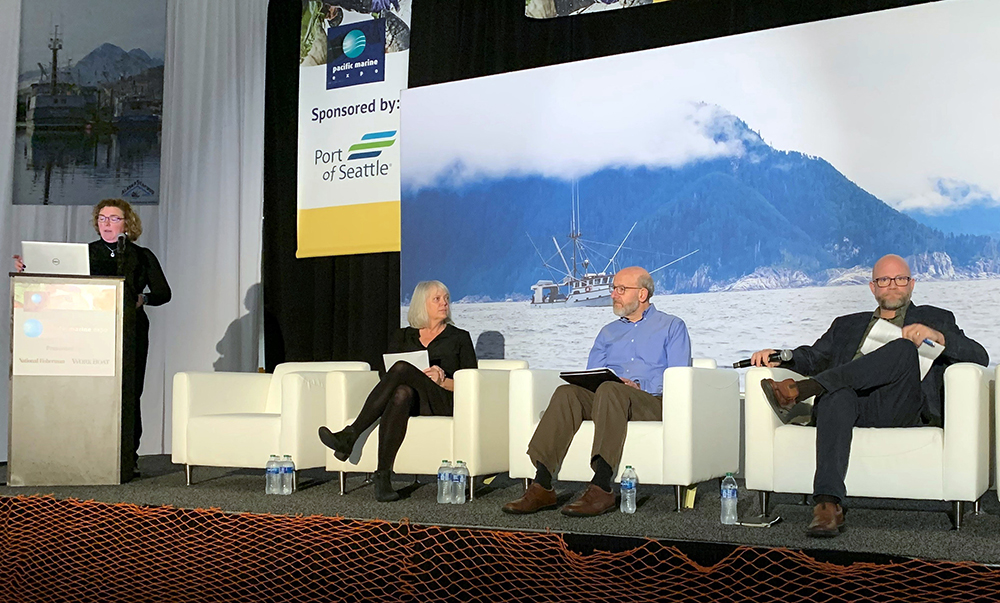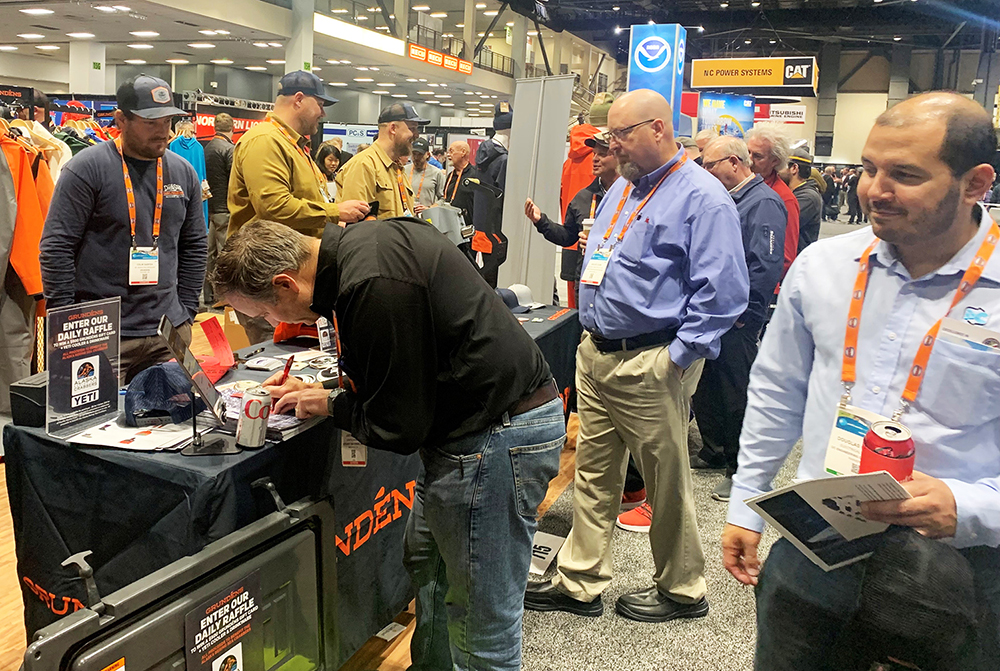
Pacific Marine Expo, the largest trade show for commercial mariners on the West Coast, returned to Seattle in November. This year’s event, held Nov. 8-10 at the WAMU Theater, attracted thousands of attendees from across the U.S. and beyond.
In addition to commercial fishermen, attendees included vessel owner/operators, engineers, architects, seafood processors, port officials, harbor engineers, marine surveyors and others involved in the maritime industry.
And in addition to hundreds of exhibitor booths, the event featured panel discussions on various topics. The expo offers a variety of informative education sessions covering such topics as marine safety, business management, regulatory issues, technical advancements and more.
This year’s event featured nine main stage panel discussions as part of an annual education program, including sustainability in shipyard and port operations, electric commercial fishing vessels, industry innovations, mental health for commercial fishermen, offshore wind, vessel safety and more.
Alaska Fisheries
NOAA Communications Director Kate Naughten moderated a panel discussion around how commercially important fish stocks have been known to wax and wane over the years, and that has happened majorly in recent years via the cancellation of Alaska’s snow and king crab seasons and other marine ecosystem changes.
Although climate-driven changes in the marine and freshwater environment have caused a decline in chinook and chum stocks in the Yukon River, Bristol Bay fishermen harvested a record 57 million sockeye in 2022.
Other species, including sablefish, have also shown signs of significant increases during recent climate variability.
The panel of four NOAA experts—Director of Communications Kate Naughten; Fisheries Assistant Administrator Janet Coit; Alaska Regional Office, Regional Administrator Jon Kurland; and Bob Foy, the Science and Research Director of the Alaska Fisheries Science Center—discussed various issues regarding Alaska fisheries.
Among the major topics explored was how climate change has impacted Alaska’s marine ecosystems that affect fisheries; the potential for predicting impacts of changing climate for certain species and areas; and the impact of extreme events on stocks that were already in decline and some, like snow crab, that had recent increases in recruitment.
Coit said it’s known that warming waters, sea level rise, more intense storms changing weather patterns, shifting stocks, are impacting fisheries and the fishing sector.
“That’s at the forefront of our minds every single day,” Coit said.
“Alaska in particular supports our most productive and valuable commercial fisheries and has a wide range of sectors and people who depend on fishing for their sustenance and for the commercial value,” she continued.
We bring high quality protein to America. So we know that for Alaskans, the effects of climate change are tangible and real, and we need to ensure that … we are understanding and predicting impacts of climate change so we can do a better job managing the valuable resource—our fisheries, our ocean habitats, our protected resources—now and into the future,” she added.

Vessel Safety
Members of the U.S. Coast Guard discuss Commercial Fishing Vessel Safety in Alaska as well as issues and trends affecting the fishing vessel safety program.
For the second consecutive year, two members of the Coast Guard Investigative Services (CGIS) agency participated in the vessel safety session.
Both men, David Chaffin and Adam Carron, said that in recent times, a new scourge has emerged in addition to other criminal matters at sea that CGIS investigates, like environmental and violent crimes.
“A big issue that we deal with nationwide right now unfortunately is fentanyl,” Chaffin said. “It’s sort of making its way into every sector of society and unfortunately the fishing fleet is no exception. We’re trying to be on the front lines of that and take on that issue.”
“With the ‘f word’ (fentanyl) so to speak, as Dave mentioned, it’s everywhere, in all parts of society,” Carron added. “The maritime domain is absolutely not even close to being immune from that. We’re seeing upticks of overdose deaths. If people don’t think it’s on their boats, they’re wrong, because it absolutely is.”
Mental Health
During the mental health panel, moderator Leann Fay, the executive director of the Alaska Marine Safety Education Association, led a discussion focusing on how stress has always been a factor in the commercial fishing industry with fishermen facing unique stressors that are not always present in other industries.
These stressors can include finances, finding competent crew, weather, boat problems, lack of sleep, chronic pain, or trauma. However, in additional to those traditional, long-time issues, fishermen have in more recent times, also faced new issues, including the uncertainty of climate change on fisheries, pandemics, inflation, rising political tensions and fish management decisions.
It can be difficult to face these challenges while being isolated in high-stress environments with limited access to physical or mental health resources. The five-member panel, which included Denise Damewood of State of Alaska Department of Health; Jeff Farvour, a longliner and troller with the f/v Apollo; Marissa Baker, an assistant professor with the University of Washington; University of Alaska Fairbanks Assistant Professor Tav Ammu; and AMSEA’s Fay, discussed ways and means of dealing with issues on a day-to-day basis.
Insights were provided when it comes to stress management methods while on the water and back on shore; identifying symptoms of stress overload and when to should reach out for help; providing resources that are available for short and long-term stress factors, substance abuse, immediate crisis, etc.
Electric Vessels
During a session titled “ Commercial Fishing Vessels Go Electric,” Noah Oppenheim of ocean policy consulting company Homarus Strategies moderated a discussion around how “going green” and other sustainability initiatives might sound like another cost on fishermen, but that the requirements and mandates associated with them can’t be ignored.
Participants in the session said that if safe, reliable and affordable next-generation propulsion solutions are going to be developed, fishermen need to be at the helm and early adopters need support.
In the short term, electrification is expected to demonstrate the fishing industry’s commitment to sustainability, while in the long term, vessel owners could save money and operate more efficiently overall.
The panel, which included Elliott Bay Design Group Technical Manager Sam Waterhouse; Tom Testaverde, owner of the f/v Midnight Sun; Alaska Longline Fishermen’s Association Executive Director Linda Behnken; and Fishery Friendly Climate Action Coordinator Sarah Schumann, delved into the topic.
The naval architects and stakeholders from various areas of the commercial fishing industry outlined how the effort to “go green” can result in operational efficiencies that ensure the long-term viability of individual businesses and the fishing industry as a whole.
Subjects included how to begin making your operations more sustainable; whether to retrofit or build new; finding fuel efficient solutions for vessels; the role of shoreside infrastructure in electrification; specific long-term benefits for businesses; the cost of going hybrid; financing electrification projects; and policy issues that must be addressed.
Industry Innovations
Noelle Yochum, a senior manager with Trident Seafoods, moderated a discussion around how technology developments for commercial fishing operations are not keeping pace with the expansion of technological capabilities or the needs of the fishing industry.
Utilizing new technology can save money, save time, and increase safety and in the session, fishermen who have implemented new technology on their vessels as well as some of the companies creating the latest products, discussed their experiences and provided some knowledge, including:
The needs and barriers for technology development and funding in commercial fisheries; identifying successful technologies and their benefits to the fishing industry; building long-term capacity for technology development; and perspectives from technology developers on ways to communicate needs or suggested modifications.
